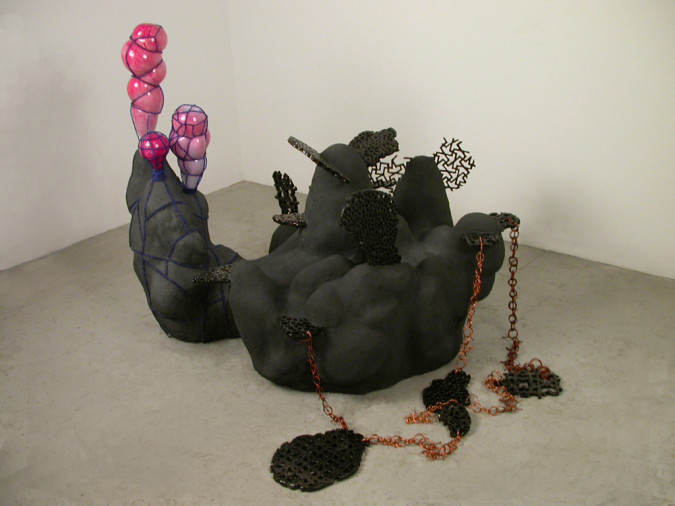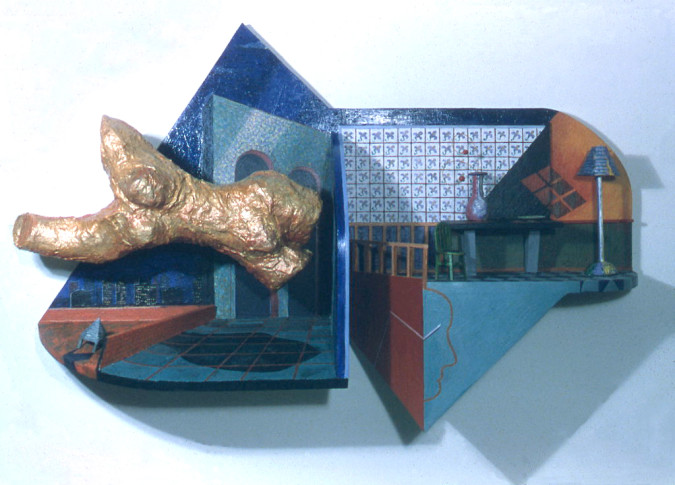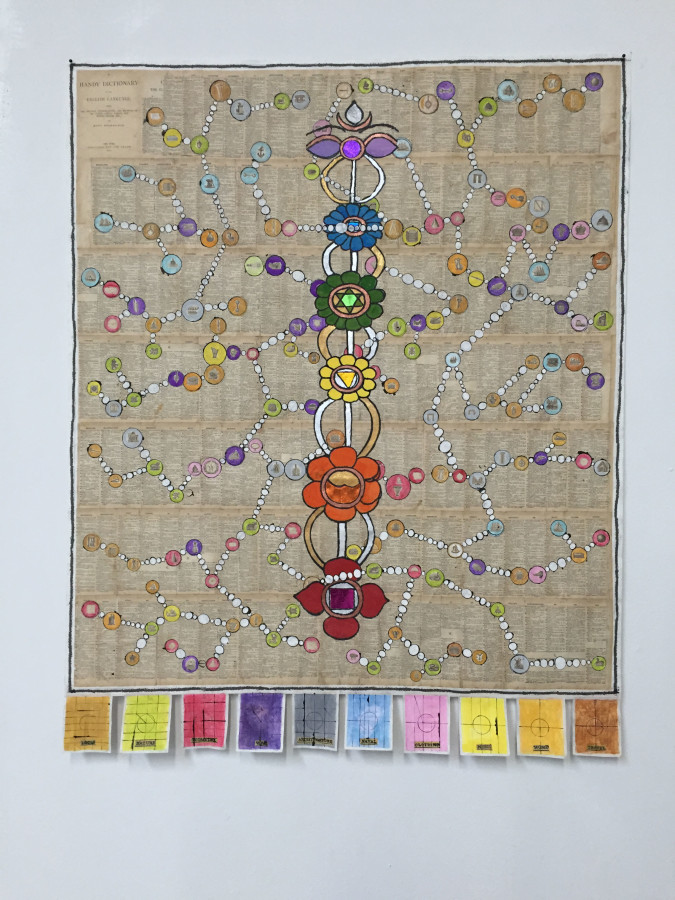Nancy Bowen
Nancy Bowen is a mixed media artist known for her eclectic mixtures of imagery and materials in both two and three dimensions. She has had over a dozen solo exhibitions throughout the United States and Europe including the Lesley Heller Gallery in NYC, Annina Nosei Gallery in NYC, Galerie Farideh Cadot in Paris, the Betsy Rosenfield gallery in Chicago, and the James Gallery in Houston. Bowen has incorporated pattern and ornament in her work since the 1970s. She discusses some of her many sources and influences in this answer.
Question
You have used ornament in your work since the late 1970s. How has your thinking about and use of ornament changed over time?
Answer
I was first introduced to the idea of ornament while in school at SAIC in the late 70’s. It was one of the many things I picked up from my ad hoc education in the burgeoning women’s art movement. I was privileged to take classes with both Ree Morton and Marcia Tucker who were visiting faculty at the school. Morton used ornament in her own work, in her flags, banners and paintings. For her, it was a way of showing pride in using a so-called “feminized” motif and a way to combat the mostly male modernist tropes dominating art education at the time. It was also incredibly joyful and beautiful, all of which appealed to me.
Both Tucker and Morton espoused the dictum “the personal is the political” and encouraged us to bring bits of our life into our artwork. I made a series of wall mounted architectural models with highly patterned ornament on the walls. Inside the rooms were gestural figurative fragments that connoted various personal narratives. (see The Sleepwalker) I had read “The Yellow Wallpaper,” by Charlotte Gilman and was interested in transforming a space using ornamental patterns. Sometimes I made the patterns with beads or other objects and sometimes they became three-dimensional. Over the years as I continued to make these pieces, the ornament disappeared while the primacy of the figurative experience strengthened. Eventually, the places disappeared entirely and the figures became the sole focus of the work. Ornament became something I loved to look at but didn’t use in my own work for another two decades.
In the 90’s and again around 2000 I traveled, searching for something to stimulate a new twist in my work. What struck me the most in India, Egypt and Turkey was the ornament, it was seemingly everywhere. In the mosques in Turkey, ornament linked the texts that swooped across the domes and down the walls. At the Red Fort, or the Amber Palace or the Taj Mahal ornament was carved into the architecture sometimes like patchwork quilts. In the Hindu shrines, fabric adorned with ornament was often used to wrap icons. While my primary interest had been in looking at sculpture, I was overwhelmed by color and pattern. I loved the excess and the wild combinations and felt that was something I could bring into my own work.
I began to use “chunks” of ornament as ways to tie different parts of a sculpture together. I thought of the ornament as “visual glue”. (see Burden) For instance in the piece Burden, I made clay tiles that mimicked specific ornament from windows in the Taj Mahal. I attached the pieces to the concrete forms of the sculpture. The ornament functioned like a thing rather than an attribute. I found that to be an interesting problem, making the pattern becomes something other than decoration so that it functioned as its own entity.
I became very curious about ornament and how it worked visually, historically, and culturally. I read a fantastic book called The Mediation of Ornament, by Oleg Grabar, an Islamic scholar. He defines ornament as “an agent that is not logically necessary to the perception of a visual message but without which the process of understanding would be more difficult. He calls it a “discourse of love” by the maker while making and by the viewer when viewing. His analysis uses Islamic ornament but his insights could be applied to any type of ornament.
I am fascinated that while ornament can be culturally bound ( i.e. one can differentiate between Islamic patterns and Inuit patterns for example), there are abstract forms that show up in various patterns but have different meanings in different cultures (a western swastika has the same form as a swastika in Sanskrit which is an auspicious symbol in Hindu, Buddhist and Jain religions).
I am also amused by the amount of historical ire that ornament has brought to the history of modernism. Adolf Loos proclaimed in his 1908 lecture “Ornament and Crime”,“The evolution of culture is synonymous with the removal of ornament from utilitarian objects.” Moderation was seen as a sign of cultural maturity. To me that is a call to use ornament!!
Another really good book on the subject is Ornament: A Modern Perspective, by James Trilling. His analysis covers more contemporary issues and brings in the question of labor. He notes that ornament in early 20th century becomes an emblem of conspicuous consumption as labor becomes a sign of leisure in women’s handiwork. My take away quote from his book is “The justification for ornament runs beyond logic, it makes people happy.”
Ornament is a rich field and can be many things to many people. For me it is a way to suggest collaboration between my culture and another culture. It is a way to credit my feminist foremothers, and it is a way to seduce the viewer into slower and longer looking.
Very recently I have been using ornament in collages.
In Handy Dictionary 1881, I layered an ornamental Hindu chakra symbol over the pages of a dictionary from 1881. I created another layer of ornament that connects the illustrations in the dictionary with chains of circles that suggest jewelry or molecular growth. I am interested in the new thing created by the layering of all this information. The fusion creates something that is not easy to describe but has its own logic and resonances. It takes time to decode it and hopefully that time is enjoyable!








